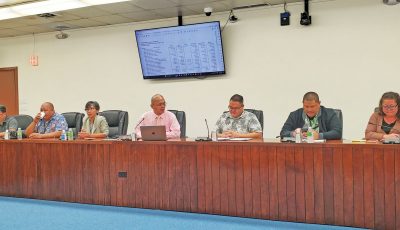US Navy works to revive starlings in Guam

A snake-resistant nest box provided for Micronesian starlings sits on a utility pole on Andersen Air Force Base. More than 200 starling chicks have hatched in protected nest boxes on Andersen since March 2016 as part of the Micronesian Starling Nest Box Project funded by the Navy. Inset shows a Micronesian starling. (NAVFAC PUBLIC AFFAIRS OFFICE)
ASAN, Guam—Working to create a healthier, more robust ecosystem for Guam, U.S. Navy officials recently celebrated a milestone in their efforts to revive the dwindling bird population of Micronesian starlings.
The Micronesian Starling Nest Box Project, which began 15 months ago on Andersen Air Force Base, aims to increase the population of Micronesian starlings in Guam.
In November 2015, a team of researchers and Naval Facilities Engineering Command Marianas scientists installed nest boxes on utility poles on AAFB, and the first starling eggs were found laid in these boxes sometime in March 2016. In May 2017, the team identified a total of 206 starling chicks that were grown enough to fly from the safety of their nest boxes.
“We believe we have made a huge step in growing birds,” said Julie Savidge, professor in the Department of Fish, Wildlife and Conservation at Colorado State University and one of two principal investigators in the project. “Everybody is really excited about that.”
Micronesian starlings—one of only two remaining native forest bird species in Guam—are the subject of this project that provides them with brown tree snake-resistant nest boxes on AAFB. This baby bird boom occurred over the course of more than a year with no sign of interference from brown tree snakes, which are responsible for the decimation of the bird population.
While the number of Micronesian starlings in Guam before the nest box program is not known, it is thought to be less than 500, according to Savidge. The starling population prior to the introduction of the brown tree snake is also not known, but was described in historical accounts as common to abundant.
“That would mean you could basically find them throughout Guam,” Savidge said. “I think that if you went out for a drive, you would see them. Now, you have to know where to look to be able to find that species.”
In addition to restoring the populations of a native bird species for cultural and aesthetic reasons, indications are the starlings have a positive impact on the island’s forests based on related research the team did on Micronesian starlings on Saipan in collaboration with a team from Iowa State University focusing on vegetation. The two universities are studying the impact of losing fruit dispersers because of predation by brown tree snakes, in a project funded by the Strategic Environmental Research and Development Program.
“We learned [on] Saipan that Micronesian starlings are one of the very best fruit dispersers of native forest tree species,” Savidge said. “They eat a variety of fruits and they disperse them pretty far. They’re dispersing them into degraded forests too, which could help restore forests.” Savidge said this species has the potential for being really important to helping maintain and restore Guam’s forests.
“I am really happy with the success of this project,” said Shermaine Garcia, natural resources specialist, 36th Civil Engineer Squadron environmental division. “I believe the research being done with starlings will contribute greatly to the development of future bird conservation strategies and forest enhancements plans.”
Currently, a total of 72 nest boxes have been installed on AAFB to support this project, and environmentalists believe its usefulness may extend beyond the starlings.
“Tree snake exclusion devices developed for this project may be helpful in bringing back the Micronesian kingfisher, a federally endangered bird that has been extirpated from Guam,” said Jim Watkins, conservation program supervisor, 36th Civil Engineer Squadron environmental division. “Because starlings and kingfishers both nest in cavities, there is hope that success with starlings can also benefit the return of kingfishers.”
The next step for the research team in Guam is to determine what happens to the starlings after they have fledged, or have flown from their nest boxes. To do that, team members have begun to attach colored bands to nestlings in the bird boxes.
In the coming months, as researchers record sightings of banded birds that have grown, they hope to be able to determine more about the birds’ lives, including how well they survive away from the protected nest boxes, and whether they return to the boxes to nest. The team also plans to attach transmitters to a smaller number of the birds so they can be tracked by telemetry. This may provide more data about the starlings’ real-time location and habits. (USN)



























